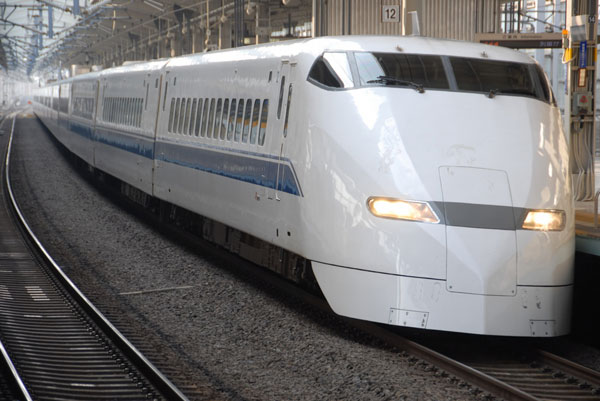Though the severity of their distaste for the state’s high speed
rail project ranges from mild irritation to unreserved outrage,
Gilroy City Council members aren’t ready to collectively speak out
against the undertaking.
Though the severity of their distaste for the state’s high speed rail project ranges from mild irritation to unreserved outrage, Gilroy city council members aren’t ready to collectively speak out against the undertaking.
Unlike Orange, a city in Southern California whose city council recently voted unanimously to oppose California’s proposed bullet train, Gilroy council members aren’t ready to formally cast their vote against the project, but their frustration with a lack of answers from the organizing agency is rising.
“I wish they would go away,” Councilman Bob Dillon said. “I’ve been against it since the get-go. It stands no chance.”
According to his calculations, the $45-billion, 800-mile system will cost more than $56 million per mile of track, and nearly $1,000 per inch, Dillon said.
“I would rather have my teeth pulled with no anesthesia” than support the project, he said.
They may not be as emphatic in their opposition, but Dillon’s fellow council members expressed annoyance with what they’ve referred to as a “dog and pony” show – the periodic presentations put on by the California High Speed Rail Authority that tend to generate more questions than answers.
Expected to begin full operations in 2020, the bullet train is slated to have routes from Sacramento to San Diego and to the Bay Area, transporting passengers at speeds of up to 220 mph. A 123-mile stretch from San Jose to Merced would run through the Pacheco Pass and will include a station in Gilroy. But a number of questions remain, including along what alignment the train will run through Gilroy, how the train tracks will be configured and just how much of the bill the City of Gilroy will be expected to foot.
Councilman Dion Bracco said he would “definitely support” a resolution similar to the one the Orange city council passed last week but Councilman Craig Gartman, whose term ends this November, said his colleagues should wait until after the new council is formed to decide if they’ll take a stand against the project. Still, Gartman has watched as residents’ and his colleagues’ attitudes toward the bullet train project have turned sour.
“Initially, there was a lot of optimism but I think that has changed a little bit as we learned more about the project,” Gartman said. “In listening to (the High Speed Rail Authority’s) presentations, it doesn’t seem like they’re very well organized. I can’t believe that they aren’t better prepared. They don’t know the answers that they should.”
But Councilman Perry Woodward said he didn’t think it was the council’s place to defy the will of the voters, who voted in Nov. 2008 to authorize the sale of $9.9 billion in bonds to support the bullet train.
“There’s a lot of political opportunities for the voters in this state to stop the high speed rail if they choose to do so,” Woodward said, adding he believes the council’s charge is to make the best of what they’ve been given.
“As someone who initially was very encouraged by the prospect that the high speed rail was coming to our town, I have grown increasingly worried and skeptical of the ability of this particular agency to build a good model,” Woodward said. “I have real concerns about the high speed rail and the people running it but I don’t think it’s our place to be telling the voters of California that we don’t want something that they’ve approved.”
As City Hall operates with a skeleton staff due to budget cuts with closures every Friday, the city doesn’t have the resources to hire its own staff to study the impact of the project and therefore must rely on information from the rail authority, Mayor Al Pinheiro said. He originally thought a downtown alignment might be beneficial for the local economy, attracting business from commuters who catch the bullet train in Gilroy.
But after further consideration, “I’m not thinking people are going to do much collateral spending in the downtown,” he said.
Pinheiro said he believes the taxpayers who voted for the initial $9.9 billion bond measure were in favor of the concept but are now balking as the project takes shape.
“I think it’s a great concept and would love to have that kind of a train until I found out it could split the downtown,” Pinheiro said.
It’s the unanswered questions that frustrate him the most, he said.
According to Gary Kennerley, a regional project manager with the California High Speed Rail Authority, part of the challenge is relaying to residents that what the authority proposing isn’t set in stone.
Last month, the rail authority released a draft document outlining the possibility of aligning a rail line with the Monterey Street corridor, with U.S. Route 101 east of Gilroy or a combination of those two routes.
“It has been hard to convey to people that this is just an identification of alternatives,” Kennerley said. “No final decisions have been made.”
And though council members have questioned the rail authority’s ridership estimates, which have been challenged by a study by the Institute of Transportation Studies at the University of California, Berkeley, among others, Kennerley said the rail authority stands behind its ridership projections. The rail authority has also used its ridership numbers to determine more than 6,000 parking spaces would be needed in Gilroy, a project Gilroy may have to pay for itself.
While the rail authority has voiced plans to seek up to $1 billion in new federal funds, the award would support sections that have already been awarded a stimulus fund, which doesn’t include the San Jose to Merced section.
More in-depth community workshops on topics such as land use and a future train station will be available in the near future, rail authority officials said. Those hands-on events will allow people to break into small groups for discussions.
Ultimately, the rail authority plans to prepare a draft environmental review document for the San Jose to Merced area by July 2011, with a final document ready by February 2012, Kennerley said. If all goes as planned, the rail authority’s board should approve final project plans in April 2012, he said.
Councilwoman Cat Tucker, who has expressed concern about the lack of hands-on meetings thus far, said she would prefer if the rail authority would run the bullet train over the Altamont Pass instead of the Pacheco Pass and bypass Gilroy altogether. Even though she considers herself an advocate for public transportation, she found both alternatives – either running the tracks through farmland or through downtown – unfavorable.
“It’s going to be one big, ugly monster coming through Gilroy,” she said.








